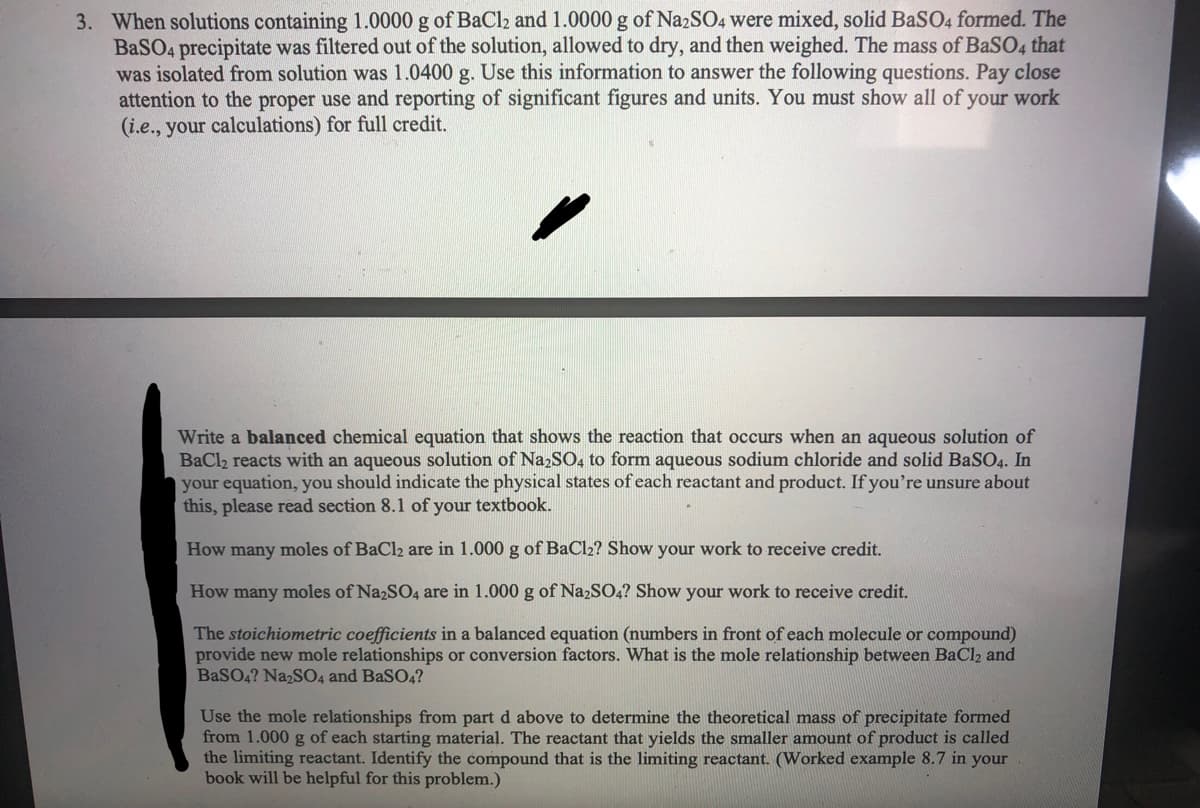3. When solutions containing 1.0000 g of BaCl2 and 1.0000 g of NazSO4 were mixed, solid BaSO4 formed. The BaSO4 precipitate was filtered out of the solution, allowed to dry, and then weighed. The mass of BaSO4 that was isolated from solution was 1.0400 g. Use this information to answer the following questions. Pay close attention to the proper use and reporting of significant figures and units. You must show all of your work (i.e., your calculations) for full credit. Write a balanced chemical equation that shows the reaction that occurs when an aqueous solution of BaCl2 reacts with an aqueous solution of NazSO4 to form aqueous sodium chloride and solid BaS04. In your equation, you should indicate the physical states of each reactant and product. If you're unsure about this, please read section 8.1 of your textbook. How many moles of BaCl2 are in 1.000 g of BaCl2? Show your work to receive credit. How many moles of NazSO4 are in 1.000 g of NazSO4? Show your work to receive credit.
3. When solutions containing 1.0000 g of BaCl2 and 1.0000 g of NazSO4 were mixed, solid BaSO4 formed. The BaSO4 precipitate was filtered out of the solution, allowed to dry, and then weighed. The mass of BaSO4 that was isolated from solution was 1.0400 g. Use this information to answer the following questions. Pay close attention to the proper use and reporting of significant figures and units. You must show all of your work (i.e., your calculations) for full credit. Write a balanced chemical equation that shows the reaction that occurs when an aqueous solution of BaCl2 reacts with an aqueous solution of NazSO4 to form aqueous sodium chloride and solid BaS04. In your equation, you should indicate the physical states of each reactant and product. If you're unsure about this, please read section 8.1 of your textbook. How many moles of BaCl2 are in 1.000 g of BaCl2? Show your work to receive credit. How many moles of NazSO4 are in 1.000 g of NazSO4? Show your work to receive credit.
Introductory Chemistry: A Foundation
9th Edition
ISBN:9781337399425
Author:Steven S. Zumdahl, Donald J. DeCoste
Publisher:Steven S. Zumdahl, Donald J. DeCoste
Chapter15: Solutions
Section: Chapter Questions
Problem 38CR
Related questions
Question
NOT GRADED !!

Transcribed Image Text:3. When solutions containing 1.0000 g of BaCl2 and 1.0000 g of Na2SO4 were mixed, solid BaSO4 formed. The
BaSO4 precipitate was filtered out of the solution, allowed to dry, and then weighed. The mass of BaSO4 that
was isolated from solution was 1.0400 g. Use this information to answer the following questions. Pay close
attention to the proper use and reporting of significant figures and units. You must show all of your work
(i.e., your calculations) for full credit.
Write a balanced chemical equation that shows the reaction that occurs when an aqueous solution of
BaCl2 reacts with an aqueous solution of NazSO4 to form aqueous sodium chloride and solid BaS04. In
your equation, you should indicate the physical states of each reactant and product. If you're unsure about
this, please read section 8.1 of your textbook.
How many moles of BaCl2 are in 1.000 g of BaCl2? Show your work to receive credit.
How many moles of NazSO4 are in 1.000 g of Na2SO4? Show your work to receive credit.
The stoichiometric coefficients in a balanced equation (numbers in front of each molecule or compound)
provide new mole relationships or conversion factors. What is the mole relationship between BaCl2 and
BaSO4? NazSO4 and BaSO4?
Use the mole relationships from part d above to determine the theoretical mass of precipitate formed
from 1.000 g of each starting material. The reactant that yields the smaller amount of product is called
the limiting reactant. Identify the compound that is the limiting reactant. (Worked example 8.7 in your
book will be helpful for this problem.)
Expert Solution
This question has been solved!
Explore an expertly crafted, step-by-step solution for a thorough understanding of key concepts.
This is a popular solution!
Trending now
This is a popular solution!
Step by step
Solved in 4 steps

Knowledge Booster
Learn more about
Need a deep-dive on the concept behind this application? Look no further. Learn more about this topic, chemistry and related others by exploring similar questions and additional content below.Recommended textbooks for you

Introductory Chemistry: A Foundation
Chemistry
ISBN:
9781337399425
Author:
Steven S. Zumdahl, Donald J. DeCoste
Publisher:
Cengage Learning

Chemistry: Principles and Reactions
Chemistry
ISBN:
9781305079373
Author:
William L. Masterton, Cecile N. Hurley
Publisher:
Cengage Learning

Chemistry: The Molecular Science
Chemistry
ISBN:
9781285199047
Author:
John W. Moore, Conrad L. Stanitski
Publisher:
Cengage Learning

Introductory Chemistry: A Foundation
Chemistry
ISBN:
9781337399425
Author:
Steven S. Zumdahl, Donald J. DeCoste
Publisher:
Cengage Learning

Chemistry: Principles and Reactions
Chemistry
ISBN:
9781305079373
Author:
William L. Masterton, Cecile N. Hurley
Publisher:
Cengage Learning

Chemistry: The Molecular Science
Chemistry
ISBN:
9781285199047
Author:
John W. Moore, Conrad L. Stanitski
Publisher:
Cengage Learning

Chemistry & Chemical Reactivity
Chemistry
ISBN:
9781337399074
Author:
John C. Kotz, Paul M. Treichel, John Townsend, David Treichel
Publisher:
Cengage Learning

General Chemistry - Standalone book (MindTap Cour…
Chemistry
ISBN:
9781305580343
Author:
Steven D. Gammon, Ebbing, Darrell Ebbing, Steven D., Darrell; Gammon, Darrell Ebbing; Steven D. Gammon, Darrell D.; Gammon, Ebbing; Steven D. Gammon; Darrell
Publisher:
Cengage Learning

Chemistry for Today: General, Organic, and Bioche…
Chemistry
ISBN:
9781305960060
Author:
Spencer L. Seager, Michael R. Slabaugh, Maren S. Hansen
Publisher:
Cengage Learning